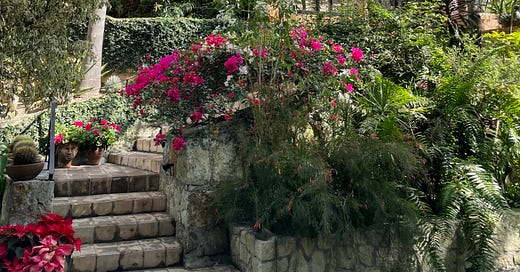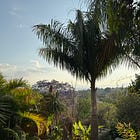Today’s entry is part of a recurring series excerpted from the book proposal I am working on. This series allows me to develop a more cohesive, linear, character-driven story about our first year in Oaxaca. The same type and variety of posts I’ve been writing will also continue to appear. The previous entry is linked to immediately below. Thank you for reading!
It was Andrea who found the Airbnb listing.
Our trip would be a working vacation and we knew we needed not just comfort, but space. Each of us would be taking video calls throughout the day and we wouldn’t have the ability to eat every meal in a restaurant. We’d need two separate work spaces, a kitchen, and some degree of tranquility around us.
Initially we looked for lodging in Oaxaca de Juárez, the metropolitan capital of the state of Oaxaca. Oaxaca de Juárez is a broad, relatively flat city which sits nestled in a junction of the Valles Centrales, the state’s central valleys. Originally a colonial city controlled by Spain, the Centro—the historic, central neighborhood where most tourists stay, eat, and shop—is a UNESCO World Heritage site.
Oaxaca de Juárez is famously charming. While the city lacks the grand, ornate beauty of Mexican cities like San Miguel de Allende or Mérida, both of which are hugely popular with American expats, what it has instead is a booming art and gallery scene, lively nightlife, great restaurants, and easy access to indigenous crafts such as hammered tin, handmade ceramics, handwoven wool rugs and linen clothing, locally grown chocolate and coffee, and mezcal, Oaxaca’s most popular distilled spirit, which is made from roasted agave fermented underground in large vats.
We knew immediately the city was where we most wanted to stay. The colonial buildings tend to be, at most, three stories high, and it has broad streets with a mix of businesses catering to locals and tourists alike. The shops are plentiful, Oaxaca’s food is famed even amongst Mexicans, and it’s an inexpensive place to visit.
Even though at the time we visited the Mexican peso was at a historic low, bestowing tourists with enormous buying power, we found that the homes we were most interested in renting were either already fully booked or well outside of our price range. Those that we could afford were strangely humble, looking very much like empty homes that had been quickly converted into rental spaces. But unlike in the U.S., where investors will fill homes with cheap IKEA furniture in order to make a quick buck, that wasn’t the case.
It’s true that in Oaxaca some people realized Airbnb is an easy way to make money, and a not-insignificant proportion of the city’s housing has been converted to short-term rentals, which also raises rents for locals. It’s an increasingly common gentrification story, and Oaxacans are increasingly being priced out of their neighborhoods. But the reason so many homes on Airbnb seemed not quite ready for guests was both because Oaxacans on the whole are low income and can’t afford to spruce up a rental unit, and because of certain culturally-bound practices related to how homes are decorated.
A lot of homes we viewed listings for seemed spartan, and photos revealed rooms lit only by either track lighting or dangling, uncovered bulbs. We learned later that some Oaxacans don’t use shades for overhead lights. Area lamps are also not common here, and Oaxacans hugely favor LED light bulbs in the “cold” end of the light spectrum, giving homes a blue, almost clinical appearance. If you go to Sam’s Club—by all accounts an American-style store targeting the city’s more affluent residents—they don’t even stock lightbulbs in the “warm” end of the light spectrum, presumably because there’s no demand for them.
Oaxacan homes also tend to be modestly decorated, without much art. Furniture is often largely functional and fairly plain, and in less affluent homes is made from predominantly from pine. In the photos we saw couches appeared to be boxy, and later, after we began looking for furniture to buy, most of what we saw and sat on was stiff and uncomfortable. Kitchens also tend to be quite modest and many lack appliances, save for a blender, which is essential for Mexican cooking, or a microwave. Bathrooms were plain, some with showers without curtains, and some of the Airbnbs had bedrooms that featured a full-size bed, a dresser, and nothing else. All of those factors combined made many of the homes we saw online look not just plain, but incomplete.
On the other hand, the properties we saw which looked immediately beautiful and comfortable were very likely owned by Oaxacans who were already more affluent, and thus more able to invest in their rental property. Unsurprisingly, the nightly rate for those homes was significantly higher.
While searching we found the homes which did have art, decor, and the kind of comfort which makes a lengthy stay seem doable were priced equivalently with staying in a hotel. Our planned multi-week stay was immediately prohibitively expensive. But comfort felt important considering we’d be spending the majority of our time within the rental itself. We began to expand our search to homes outside of the city.
“Take a look at this one,” Andrea texted me one afternoon. I was sitting at my desk in our bedroom, which sat at the top of a winding, black iron staircase. Our apartment was a duplex with our bedroom sitting on a room built on the roof of our apartment building, and was not large enough for us to have two, proper office spaces. My desk was positioned in the corner of our room, squeezed between our bed and a dresser, giving me approximately 4 square feet of work space. Winter light filtered in through the two windows under which our bed sat, and the only noise was the whir of my laptop and the distant rumble of bus engines and the honking of horns coming from Columbus Avenue.
The listing was titled “Beautiful home in San Agustín Etla,” and googling the location revealed it was about a 25 minute drive from the city center. The photos were gorgeous, showing a large, multi-level home shrouded in trees and shrubbery. In every photo the sky was a clear, deep blue, with large drifts of puffy clouds. There was a pool with lagoon-blue water, lots of ornamental statuary, comfortable looking chairs and couches festooned with pillows, and the entire house was an explosion of color, from the paint on the walls to the home’s many hand-woven rugs.
We’d already resigned ourselves to staying outside of the city, and Andrea’s find sparked very little discussion. We put in a request for a booking and soon enough received a response saying we had been approved. We’d found where we’d be staying during our time in Oaxaca.
Our flight to Oaxaca was benign and our arrival at the airport uneventful. The only small hiccup was that, due to covid, our rental car company unexpectedly didn’t have an open kiosk in the airport. They did send a driver for us, though, who drove us to the rental office in the Centro. We soon had our rental car, a rather sad, white compact Suzuki sedan we immediately had very little confidence in. Our concerns were substantiated a few days later when it abruptly refused to turn on, leading the company to swap us into a significantly nicer compact SUV.
It was nighttime as we navigated the highway which led from the city center to the village where we’d be staying. Our route took us over a towering hill with a winding road which provided a sweeping view of the city. At night Oaxaca de Juárez appears like a star field, every house and business lit from the inside by those same, frigid blue-white LED bulbs. The city lights abruptly cut off as construction halts at the foot of the mountain range which surrounds the high altitude ciudad, an expanse of twinkling illumination bordered by darkness.
The highway to San Agustín Etla was busy, and is the kind of semi-urban hinterlands found on the outskirts of cities all over the world. As we drove we saw huge, darkened tractor trailer trucks pulled over, their drivers presumably taking mandatory rest breaks in the cabs. We passed dozens of late night taquerias, most of which were serving al pastor, the shawarma-style Mexican tacos filled with slices of pork carved off of a huge, tornado-shaped cone of meat which is blasted with heat by either a vertical broiler or hand-held gas-powered flamethrowers.
The highway split, the right fork taking us down a highway with less traffic. Soon we approached our designated turn and found ourselves winding down a sleepy, sparsely lit road which gently climbed upwards. As we drove the volume of trees and bushes increased, our environment becoming more and more green, the road ensconced by towering, leafy trees. There were what seemed like dozens of speed bumps, some of which could be flown over at speed and others which required care and attention.
For about 15 minutes we were lost, mislead by Google Maps to a spot not even remotely close to where we needed to be. Stray dogs surrounded our car as we navigated our way down the hill we had errantly climbed, and we began paying far closer attention to the written directions provided to us by our hosts, Penny and Victor. We turned up a steep paved road and took a tight turn, the surface suddenly becoming uneven, rocky dirt. We carefully navigated our way down the road until, suddenly, it terminated at a gate.
Penny and Victor were waiting for us, and they opened the metal gate to the property, allowing us to drive in. The house lay above the gravel parking area. It and the surrounding garden were lit by spotlights and the house towered above us, the light flickering as the wind moved the palm trees, vines, and succulents. We had made it.
The next morning I took a photo of the house from where we had parked. Just about two years later, we would be that home’s new owners.







I love Oaxaca. We got stuck there - our van's transmission went out - for 4 months last year. One of the things I love most is all the amazing little towns that surround the city. Looking forward to reading more of your story.